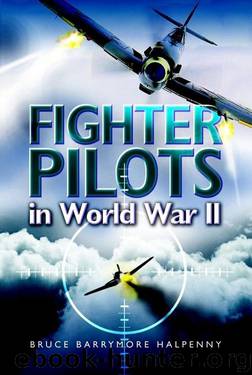Fighter Pilots in World War Ii: True Stories of Frontline Air Combat by Bruce Halpenny

Author:Bruce Halpenny [Halpenny, Bruce]
Language: eng
Format: epub
ISBN: 9781783460120
Publisher: Pen & Sword
Published: 2004-09-18T21:00:00+00:00
Course No 18 at No 8 Advanced Flying Training School at Montrose, May 1940. Ray Sellers is top left. He was at Montrose from 9 April to 25 July 1940, followed by three weeks at No 6 OTU, Sutton Bridge, converting to Hurricanes. He joined 111 Squadron on 17 August 1940 with 228 hours flying in his log-book, 34 hours on Hurricanes’
‘My earliest recollections are of two Sergeant pilot veterans of the brief Norway campaign, who had, I believe, flown off HMS Glorious before she was sunk in the North Sea whilst bringing aircraft and personnel home to UK. These were Sergeant “Tubby” Earp and his friend Sergeant Gooderham, but who was grounded because his eyes had been temporarily damaged by the heat of an incendiary bullet which had passed through his cockpit and had narrowly missed his head.
‘Action stemmed mainly from standing patrols – mostly over Essex and Kent – at heights between 15,000 and 25,000 ft, although log-book entries indicate that on the majority of patrols no engagements were reported and one can only assume that the squadron was acting as a deterrent in helping to keep enemy bombers and fighters at a considerable height rather than allowing them to dive unchallenged on targets in and around London. In most instances Me 109s had the advantage of height over the Hurricane and of speed in a dive, so that it was mostly when combat was joined that it was possible to exploit the manoeuvrability and robustness of the Hurricane. Two occasions are recorded – on 27 October and 1 November – when patrols were flown at 29,000 ft and 31,000 ft respectively and the aircraft were wallowing through the air, about as effectively as flying elephants. On the second occasion the squadron was attacked over Dover from above and behind by a flight of Me 109s and at least one Hurricane was damaged – mine!
‘At that time reports were circulating that British pilots taking to their parachutes were being attacked by the enemy on their way earthwards. Consequently, wherever possible, protection was given by Hurricanes and Spitfires. On 27 September 1940, I was able to perform this role after an engagement with Me 109s near Rochford at about 15,000 ft. It was later a pleasure to meet the pilot concerned who had been badly burned in the process of baling out, but lived to tell the tale.
‘An abiding memory is the familiar one of a sky full of aircraft one minute and completely empty seconds later after an evasive turn or dive. Conversely, it was possible to feel completely alone and yet be within seconds of being attacked. Constant vigilance particularly above and behind was essential for survival which entailed much screwing of the neck and weaving of the aeroplane. The mirror above the cockpit was too small and subject to too much vibration to be reliable.
‘Another feature which comes to mind was the intense cold which gradually penetrated fur-lined boots, flying suits and gloves during a one-and-a-half-hour patrol at 20,000 ft in the autumn of 1940.
Download
This site does not store any files on its server. We only index and link to content provided by other sites. Please contact the content providers to delete copyright contents if any and email us, we'll remove relevant links or contents immediately.
| Automotive | Engineering |
| Transportation |
Small Unmanned Fixed-wing Aircraft Design by Andrew J. Keane Andras Sobester James P. Scanlan & András Sóbester & James P. Scanlan(32573)
Navigation and Map Reading by K Andrew(4889)
Endurance: Shackleton's Incredible Voyage by Alfred Lansing(4505)
And the Band Played On by Randy Shilts(2014)
Wild Ride by Adam Lashinsky(1870)
The Box by Marc Levinson(1861)
Top 10 Prague (EYEWITNESS TOP 10 TRAVEL GUIDES) by DK(1851)
The Race for Hitler's X-Planes: Britain's 1945 Mission to Capture Secret Luftwaffe Technology by John Christopher(1741)
The One Percenter Encyclopedia by Bill Hayes(1717)
Trans-Siberian Railway by Lonely Planet(1629)
Girls Auto Clinic Glove Box Guide by Patrice Banks(1620)
Looking for a Ship by John McPhee(1572)
Batavia's Graveyard by Mike Dash(1549)
TWA 800 by Jack Cashill(1523)
Fighting Hitler's Jets: The Extraordinary Story of the American Airmen Who Beat the Luftwaffe and Defeated Nazi Germany by Robert F. Dorr(1517)
Troubleshooting and Repair of Diesel Engines by Paul Dempsey(1498)
Good with Words by Patrick Barry(1496)
Bligh by Rob Mundle(1488)
Ticket to Ride by Tom Chesshyre(1479)
